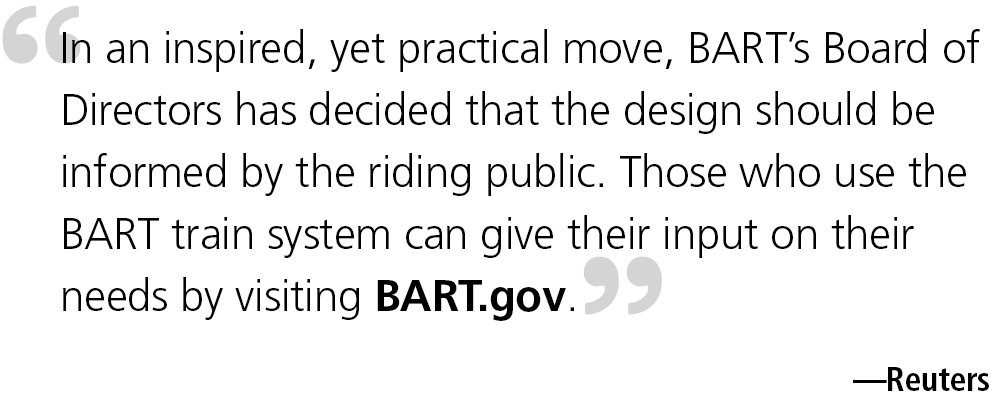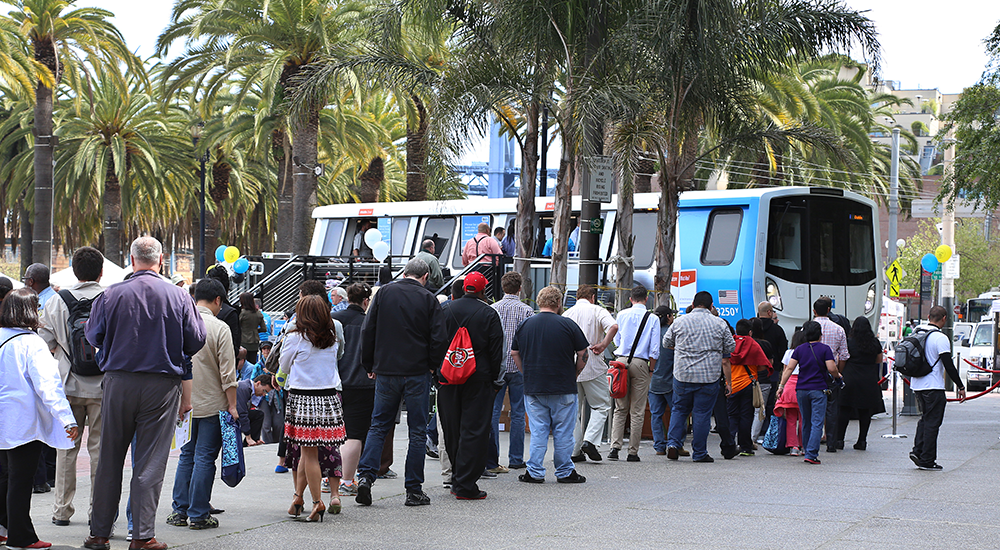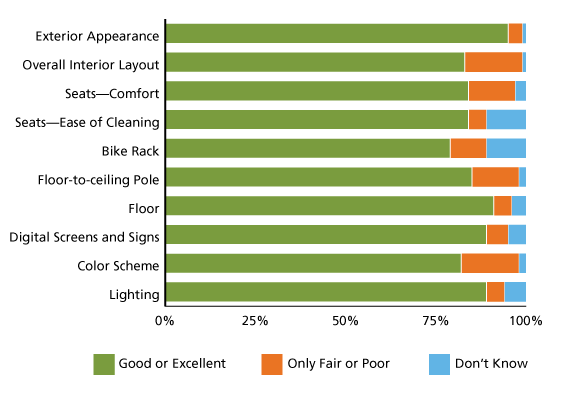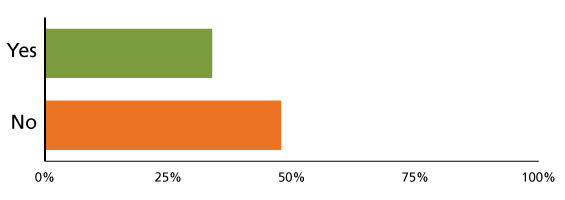
Public input has been an important part of the design process for the Fleet of the Future. Since the project began in 2009, BART has collected feedback on current and proposed designs to help inform the design process.
To date, over 40,000 people have offered input that has helped BART and Bombardier make design decisions, including more than 17,000 who visited the final train car model at one of ten locations throughout the Bay Area in April – May 2014.

Final Train Car Model
Reaction to the final train car model was extremely positive. Among the 7,666 people who completed surveys after touring the model, most rated every attribute as “excellent” or “good.” The exterior appearance and the non-carpet floor received the highest ratings. Complete survey results are available here.

Final train car model survey results, n=7,474-7,486
Over 5,000 people also wrote comments on their survey forms. In addition to broad compliments like “I like the new design,” the digital screens and signs were frequently mentioned as a much-welcomed new feature.
Of course, not all of the comments were positive. For example, some expressed concern about the number of seats on the new cars. To address this, BART has set a goal to increase the size of the fleet from 669 to 1,200 train cars, which will result in a net increase in seats of more than 60%. BART is also planning an upgrade to the train control system to allow BART to run more trains, more frequently.
The new bike rack elicited a range of comments – from ‘does not provide enough dedicated space for bicycles’ to ‘provides too much dedicated space for bicycles.’ 79% of survey respondents gave the bike rack an Excellent or Good rating. Among the 10% of survey respondents who rated the bike rack as Only Fair or Poor and who provided a comment, 43% wrote a comment that was generally against having bikes on BART, 36% supported more accommodation of bikes, and the balance were indeterminate.
The design of the final train car model also took into account customer feedback from previous outreach. In summer 2013, customers evaluated BART’s initial train car model at MacArthur Station, and in fall 2013, customers tested seat prototypes and bike rack prototypes at various locations. Below are a few examples of changes that were made based on customer feedback.
Armrests: Prior seat designs included an armrest between pairs of seats, and feedback was mixed. Some customers liked the middle armrests because they gave them something to push up against to stand up from a seated position, and they provided a greater feeling of separation between strangers sitting in adjacent seats. Others preferred not to have armrests to make it easier to slide over into a window seat, to provide extra space for larger riders, and to more easily accommodate more than two children on a two-person seat bench. In a fall 2013 survey, a plurality of customers opposed the armrests; therefore, the final train car design does not include middle armrests.

Armrests have been included on the sides of seats adjacent to doorways, however, for safety reasons.
Flip down seats in bicycle area: The initial train car model design included three flip down seats in the bicycle area. Some customers expressed concern about the shared space and conflicts it could create between customers. As a result, the flip down seats were removed. This will help the bike area do its job of keeping bikes out of the way and not blocking seats, aisles, and doorways.

Legroom: Customers told us that they needed more legroom in the window seats adjacent to side-facing seats (see photo below). We were able to engineer a solution that added more than one inch to the legroom in this location, and the final train car model incorporated this change.
In addition to the public events mentioned above, over the last two years thousands of customers have sent us emails, filled out online surveys, or attended one of the dozens of design review events we have held throughout the Bay Area. Here are the top categories of feedback we have received, along with a BART response:
| Feedback | BART Response |
| Adequate number of seats | Having thinner seat backs help with seat count, but new buffer zones for crash safety at the ends of the car, and an extra door in the middle, are limiting factors. As a result, seat count will drop by 4.6 seats per car on average. To increase the number of seats in the fleet, BART has set a goal to obtain funding to increase the fleet to 1,200 train cars. This would increase the number of seats in the fleet by more than 60%. |
| Seat and aisle width | 80% of randomly surveyed customers at the MacArthur train car model rated a 20” seat width as excellent or good. The new seats are 2” narrower than the seats on the old BART train cars, but still among the widest in the industry and allow for wider aisles and fitting as many seats as possible in the available space. |
| Higher seats | The new seats are about 18 inches high off the floor, about 1.5 inches higher than the current cars by popular demand. 88% of randomly surveyed customers at the MacArthur train car model rated the seat height as excellent or good. |
| Better passenger information | Lots of improvements. LCD screens on the train to display dynamic BART maps that show customers where they are and where the train is going; interior LED displays showing the next stop; exterior LED displays showing the destination of the train and the route color; automated PA announcements, and more. |
| Quieter ride | Noise dampening, microplug doors provide a quieter ride and a new tapered wheel shape will reduce track noise. |
| Cooler cars | Cooling systems distribute air directly from the ceilings, making it more comfortable for standees on hot days. |